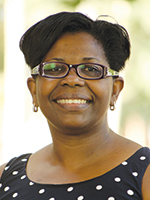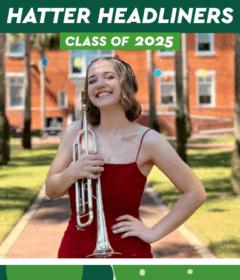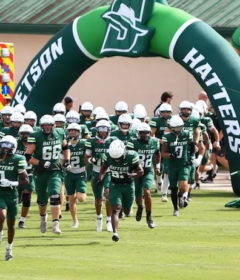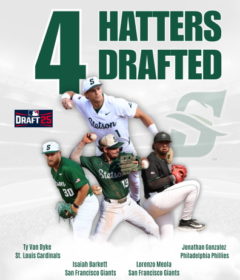Balancing Research and Teaching


There may not be greasepaint or wild animals, but sometimes university faculty may wonder whether they have mistakenly chosen life under the Big Top: juggling while trying to keep their balance on a high wire.
That’s a little bit how it feels to try to meet the twin demands of the study and the classroom, research and teaching. And increasingly there is a third element to add to the apparently conflicting mix: service.
Is it really possible to do it all, to excel in each sphere? Can you keep all the balls in the air? Or does something simply have to give?
The question is “spot on,” according to one Stetson professor asked about workplace tension — who illustratively went on to decline an interview request because, the professor explained, the workload meant there was no spare time to talk for several weeks.
For Doug McKee, Ph.D., associate chair and senior economics lecturer at Yale University, the answer is clear.
“It’s almost impossible for a junior professor to be a great teacher and a great researcher,” wrote McKee in a blog post noting the importance of publishing in hiring, promotion and tenure. “One has to give, and that’s teaching.”
In a follow-up email to Stetson University Magazine, McKee observed “most faculty understand that teaching matters little in the hiring and promotion process at pretty much any research-focused university.” He may have been unusually candid about things, but McKee’s is by no means a minority opinion.
“Many faculty members at research universities report that they have a tough time getting higher-ups’ attention for anything but research and securing grant money, making teaching a decidedly lower priority,” Inside Higher Ed noted in an August 2015 article.
PUBLISH OR PERISH
Historically, this “publish or perish” pressure, as it is widely known, has been greater at major research universities. But times are changing.
“For more and more faculty, there is a creeping increase towards more and more scholarship and publication, because that is where competition is settled,” said Craig Vasey, Ph.D., chair of the committee on teaching, research and publication for the American Association of University Professors. “The people who publish more do get rewarded for that. The people who teach better don’t generally get rewarded for that because that’s part of your job, to teach and to teach well.”
The research-teaching tension is not a new topic of conversation — nearly 20 years have passed since publication of the Boyer Commission on Educating Undergraduates in the Research University’s influential Reinventing Undergraduate Education: A Blueprint for America’s Research Universities, which advocated a major overhaul of existing practices to improve teaching standards affected by the lean toward research.
More recently, Association of American Universities (AAU) President Hunter R. Rawlings acknowledged that “there has been a lot of reward for great research but not as much for great teaching” at the nation’s top-tier research universities. His assertion: “Our teaching should be better.”
His comments were made in a video on the organization’s website that highlighted how the research-teaching conflict doesn’t just affect faculty but students: It noted that 90 percent of students who switched out of science fields cited poor teaching as a major concern.
The video introduces the association’s 2011 STEM initiative, encouraging creative new teaching methods and approaches in STEM classes. The pilot projects at eight universities across the country don’t just focus on ways individual faculty can improve their teaching, but how to encourage institutions to raise the level of commitment to teaching overall. Part of that encompasses studying how involving undergraduate students in research benefits students and faculty alike.
MARRYING TWIN DEMANDS
“Some faculty think they move their scholarship ahead more with undergraduate co-researchers because they often bring different and diverse insights into the problem they are focused on or trying to resolve,” said Beth Ambos, Ph.D., executive officer at the Council on Undergraduate Research.
This philosophy, bringing research and teaching together as complementary rather than competing activities, is part of the AAU effort and one of the central ways in which Stetson seeks to minimize that research-teaching tension.

“We have to understand how to marry those two important components of our role, in order for what appears to be a tension to disappear,” commented Rosalie Richards, Ph.D., associate provost for Faculty Development and professor of chemistry and education. Richards also oversees Stetson’s Brown Center for Faculty Innovation and Excellence.
Bringing research, teaching and even service together is “almost like taking a thread from wool and weaving these things together in ways that reduce the tension of having these three strands that are running parallel to each other, and trying to steal from Mary to pay Paul,” Richards said.
Such has been the case for Terry Farrell, Ph.D., professor of biology, who has twice been honored for outstanding teaching at Stetson. By embracing the teacher-scholar identity championed at the school, “you are saying someone is both, simultaneously,” he commented. “I think a lot of us really want to look at it that way, that our scholarship is not distinct from our teaching, and it is all kind of wrapped into one,” Farrell said. “When you generate situations in which the research endeavor and the teaching are combined, all of a sudden you don’t have the tension between the two; they are actually kind of synergistic activities. Each furthers the other.”
That is not necessarily easy, though. Involving students in research may be easier in some areas and disciplines than others, Farrell recognized. For instance, the study may require “high levels of mathematical skills or other deeply specialized knowledge, language skills that a typical undergraduate couldn’t have.”
Michael Denner, Ph.D., underscored that reality. “I don’t know any undergraduate in the United States who could do what I do and have to do for my research,” said the Stetson professor and director of Russian, East European and Eurasian Studies, who is also director of the University Honors Program and editor of the Tolstoy Studies Journal.
Combing through archives in search of relevant articles and references requires language and history skills “no student could possibly be expected to have.” For his part, Denner feels the expectation that students take part in research is “often naive.”
Denner also observed that, though they may be good teachers, many faculty enter academia primarily to do research.
“We didn’t get into the game to teach. We like to, many of us are very good teachers, but that’s not why I got in,” he commented. “I wanted to solve big problems. I love to talk with other people about things that nobody else cares about. That’s what I wanted to do and that’s what I was trained to do and that’s what I continue to do, but it is vastly removed from what I do in the classroom.”
The emphasis on research over teaching may be true at Yale and similar schools, observed Kirsten Work, Ph.D., Stetson professor of biology, “but if anything we probably have the opposite problem: that our research suffers because we spend a lot of time teaching.”
In part, she went on, that’s just the nature of a liberal arts school: “If somebody doesn’t really like being in the classroom, they are probably not going to come to [one].”
By Andy Butcher
Note: This article originally appeared in the Spring 2016 issue of Stetson University Magazine. To read the entire magazine, click here. The next issue of the magazine is scheduled for publication this fall.



